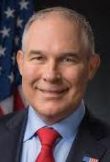WASHINGTON, D.C. – The Environmental Protection Agency said Wednesday its deregulation actions and other agency changes led by Administrator Scott Pruitt during his first year in office could save Americans more than $1 billion in regulatory costs.
The EPA’s announcement touts a year-in-review report that looks at 22 deregulation actions, including moves to “refocus” the agency’s mission, shift regulatory power to states and improve agency processes.
Supporter Spotlight

“In just one year, we have made tremendous progress implementing President Trump’s agenda by refocusing the Agency to its core mission, restoring power to the states through cooperative federalism, and adhering to the rule of law,” EPA Administrator Scott Pruitt said in the announcement. “The American people can now trust that states and stakeholders will be treated as partners, and regulations will provide clarity, not confusion.”
Pruitt’s recent actions have included a proposal to roll back rules on coal ash disposal and ending a program examining the effects of toxins on children’s health.
The EPA’s announcement follows and appears at odds with a report the Office of Management and Budget released Friday that found that regulations, including those targeted by the Trump administration, provided benefits that far outweighed their costs, without negatively affecting jobs or economic growth.
The OMB report finds that of all new regulations enacted — mainly during the Obama administration — environmental regulations, while among the costliest, also provided the most benefit.
The estimated annual benefits of major federal regulations reviewed by OMB from Oct. 1, 2006, to Sept. 30, 2016, for which agencies estimated and monetized both benefits and costs, were between $287 and $911 billion while their costs were between $78 and $115 billion. For EPA rules alone, the benefits were $195.8 to $705.7 billion, versus $54.1 to $64.8 billion in costs. OMB said the ranges reflect uncertainty in the benefits and costs of each rule at the time that it was evaluated.
Supporter Spotlight
“Of the EPA’s 26 air rules, the highest estimated benefits are for the Clean Air Fine Particle Implementation Rule issued in 2007, with benefits estimates ranging from $19 billion to $167 billion per year; and the National Emission Standards for Hazardous Air Pollutants From Coal- and Oil-Fired Electric Utility Steam Generating Units (“MATS”26) issued in 2011, with benefits estimates ranging from $28 billion to $77 billion,” according to the OMB report.
The OMB report acknowledges that the costs and benefits are not necessarily borne by the same people. In other words, industry bears most of environmental regulatory costs, but the American public reaps most of the benefits.







